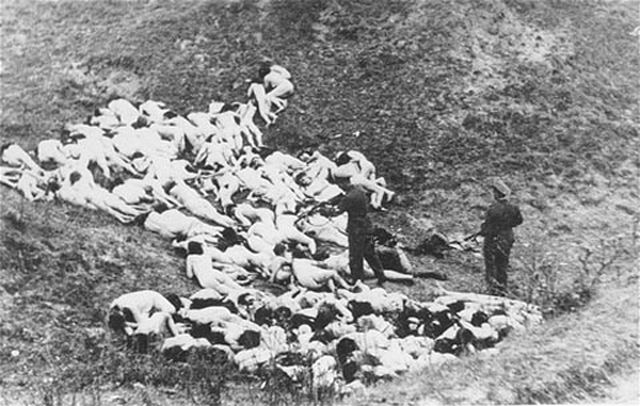Also known as Mizoch Ghetto Ghetto 1,700 population Year 14 October 1942 | Perpetrators Einsatzkommando Date dissolved October 1942 | |
 | ||
Location Near Równe in eastern Poland, now Rivne in western Ukraine. Incident type Imprisonment without due process, forced labor, mass shootings Organizations Einsatzgruppen, Ordnungspolizei, Ukrainian Auxiliary Police | ||
The Mizocz Ghetto (German: Misotsch) was a World War II ghetto set up in occupied Poland by Nazi Germany for the forcible separation and mistreatment of Polish Jews. Before the Nazi-Soviet invasion of 1939 the town of Mizocz was located in the Zdołbunów county of the Wołyń Voivodeship in the Second Polish Republic. Mizocz (now Mizoch, Ukraine) is situated some 18 miles (29 km) east of Dubno, which was the County seat.
Contents
Jews settled in Mizocz (Yiddish: מיזאָטש) in the 18th century. In 1897, the total population of the town was 2,662 with 1,175 Jews owning factories for felt, oil and sugar production, as well as the flour mill and saw mills. Some Jews emigrated during World War I. According to national census of 1921 in the newly reborn Poland there were 845 Jews in Mizocz, most of them identifying with the Turzysk Hasidism. Their numbers grew as the Polish economy improved. It was an urban community between world wars like many others in eastern Poland, inhabited by Jews and Poles along with members of other minorities including Ukrainian. There was a military school in Mizocz for the officer cadets of the Battalion 11 of the Polish Army's First Brigade; the Karwicki Palace (built in 1790, partly destroyed by the Bolsheviks in 1917), Hotel Barmocha Fuksa, a Catholic and an Orthodox church, and a Synagogue. The nearest major city was Równo.
Controlled by the Red Army since September 1939, Mizocz was overrun by the Wehrmacht in the course of the 1941 German attack on the Soviet positions in eastern Poland. Some 300 Jews escaped with the retreating Russians.
Uprising and mass killings
On October 12, 1942, the closed-off Ghetto of about 1,700 Jewish people was surrounded by Ukrainian auxiliaries and German policemen in preparation for the ghetto liquidation action and the pacification of its Jewish occupants. The Jews fought back in an uprising which may have lasted as long as two days. About half the residents were able to flee or hide during the confusion before the uprising was finally put down. On October 14, the captured survivors were transported in lorries to a secluded ravine and shot one by one.
Photographs
The shootings were photographed. The images owned by SS-Unterscharführer Schäfer until 1945 became part of the Ludwigsburg investigation (ZSt. II 204 AR 1218/70). They were published, and have become well known. Frequently the photographs are erroneously said to depict other Holocaust shootings.
Two of the photographs show the "Aktion" in progress. The photographs give clear evidence of the execution practice common during the Holocaust by bullet in Reichskommissariat Ukraine. The victims were led to the killing place in groups of around five or so individuals, and forced to lie down among the prior victims, to be shot in the back of the neck or head, with a single bullet. Historians have commented upon the brutality shown in the Mizocz mass murder photographs:
In 1942 at Mizocz, in the region of Rovno in Ukraine, approximately 1,700 Jews were executed. The photographs show large numbers of people being herded into a ravine, women and children undressing, a line of naked women and children in a queue and finally their executed bodies. Two particular harrowing photographs show German police standing among heaps of naked corpses of women strewn on either side of the ravine.
The killings did not stop there. Mizocz was the site of the OUN-UPA massacre of about 100 Poles by Ukrainian nationalists in late August 1943. Some 60 percent of the homes were set on fire and burned. Among the victims was Ukrainian carpenter Mr Zachmacz and his entire family, murdered along with the Poles because he refused to enter the fray. His eight-year-old son survived hiding with the Poles.
Following World War II, at the insistence of Joseph Stalin during Tehran Conference confirmed (as not negotiable) at the Yalta Conference of 1945, Poland's borders were redrawn and Mizocz – then again, Mizoch (Cyrillic: Мизоч) – was incorporated into the Ukrainian SSR of the Soviet Union. The remaining Polish population was expelled and resettled back to new Poland by the NKVD before the end of 1946. The Jewish community was never restored. The USSR officially ceased to exist on 31 December 1991.
